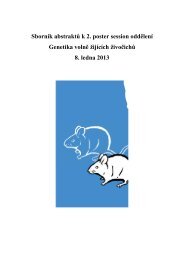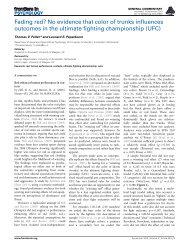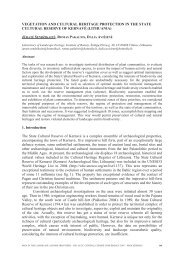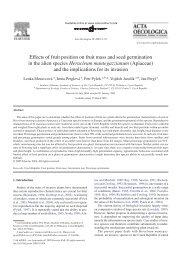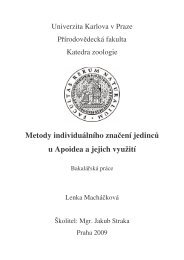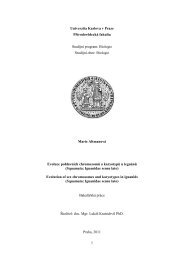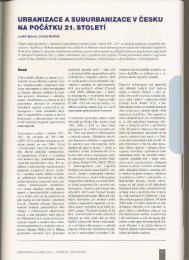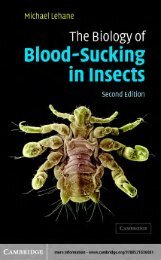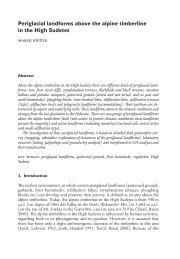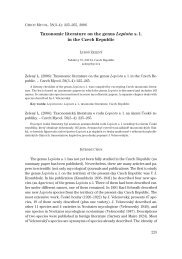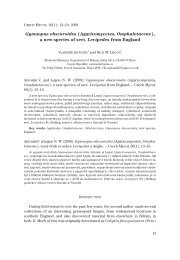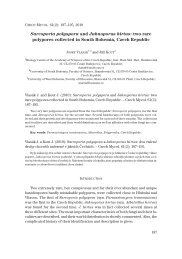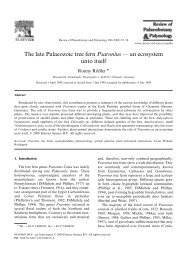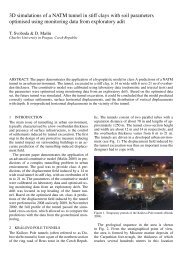The wood-rotting bluing Psilocybe species in Central Europe – an ...
The wood-rotting bluing Psilocybe species in Central Europe – an ...
The wood-rotting bluing Psilocybe species in Central Europe – an ...
Create successful ePaper yourself
Turn your PDF publications into a flip-book with our unique Google optimized e-Paper software.
p. 111), Stamets (2000, p. 327, 1 colour plate), Stamets (2005, fig. 342), Stamets<br />
<strong>an</strong>d Gartz (1995, fig. 5), ? Stijve (2004, fig. 2), Tjall<strong>in</strong>gii-Beukers (1976, p. 39).<br />
Excluded illustrations. Abhardt <strong>an</strong>d Lohmeyer (2001, p. 154), ? Arora<br />
(1986, plate 88), Assisi et al. (2008, p. 302), Babos (1997, p. 11), Boccardo et al.<br />
(2008, fig. 769), Bon <strong>an</strong>d Roux (2003, p. 48), ? Cetto (1995, fig. 913), Eul (1999, p.<br />
49; 5 fruitbodies <strong>in</strong> the left), Follesa et al. (2006, p. 74), Gartz (1996, fig. 2), Gartz<br />
(1999, figs. 3.4 <strong>an</strong>d 10.1), Grilli (1990, p. 116<strong>–</strong>119), Hagara et al. (1999, fig. 366),<br />
Hlaváček (1996, fig. 1), Krieglste<strong>in</strong>er (1984, 1 colour plate), Kunc (1981, appendix,<br />
figs. 2 <strong>an</strong>d 3), Mao (2000, figs. 646 <strong>an</strong>d 647), Michael et al. (1985, fig. 265b), Moser<br />
<strong>an</strong>d Jülich (1996, pl.: III <strong>Psilocybe</strong> 10), Pilát (1969, fig. 27), Roux (2006, p. 901).<br />
N o t e . An error occurred <strong>in</strong> my study on P. cy<strong>an</strong>escens (Borovička 2005); see<br />
the correction <strong>in</strong> Mykol. Sborn. 82(3): 112.<br />
C o l l e c t i o n s e x a m i n e d . B 700000536, E 186682, E 186684, E 186685, E 186686, E 186687,<br />
K (M) 85041, K (M) 28453, K (M) 85043, K (M) 31416, K (M) 63976 (holotype), L 0194081, LIP<br />
PAM3110805 [duplicate: PRM 909549], LUG 7565, PRM 893653, PRM 896513, PRM 901021, PRM 901040,<br />
PRM 901480, PRM 901481, PRM 901482, PRM 901838, PRM 902040 [ex GENT], PRM 902041, PRM<br />
902042, PRM 902043, PRM 902044 [ex GENT], UBC (F) 577, UBC (F) 1503, UBC (F) 1512, UBC (F) 1513,<br />
UBC (F) 10095, <strong>an</strong>d UBC (F) 12155.<br />
<strong>Psilocybe</strong> azurescens Stamets et Gartz, Integration 6: 21 (1995)<br />
P. azurescens is a dist<strong>in</strong>ct <strong>species</strong>, closely related to P. cy<strong>an</strong>escens. It c<strong>an</strong> be<br />
easily dist<strong>in</strong>guished by macrocharacters (acutely umbonate pileus <strong>an</strong>d fibrillose<br />
<strong>an</strong>nular zone on stipe) <strong>an</strong>d microcharacters (longer spores).<br />
D i s t r i b u t i o n . An Americ<strong>an</strong> <strong>species</strong>, <strong>in</strong>troduced to <strong>Europe</strong>; for the first time<br />
reported from a natural habitat <strong>in</strong> Germ<strong>an</strong>y (Gm<strong>in</strong>der 2001). Its occurrence <strong>in</strong> <strong>Europe</strong><br />
has most likely been caused by recent amateur outdoor cultivation; next<br />
f<strong>in</strong>ds are expected <strong>in</strong> the future. I have also studied one collection found on 19th<br />
October 1966 <strong>in</strong> Royal Bot<strong>an</strong>ic Garden Ed<strong>in</strong>burgh (E 186683) that might be attributed<br />
to this <strong>species</strong>; however, the herbarium specimen was <strong>in</strong> a bad state <strong>an</strong>d not<br />
all the features necessary for doubtless identification could be observed.<br />
P h e n o l o g y. Probably similar to P. cy<strong>an</strong>escens.<br />
Selected illustrations. Gartz (1999, figs. 11.1<strong>–</strong>11.4), Gm<strong>in</strong>der (2001, p.<br />
32<strong>–</strong>33), Stamets (1996, p. 94<strong>–</strong>95), Stamets (2000, p. 330, 1 colour plate), Stamets<br />
(2005, figs. 124 <strong>an</strong>d 348), Stamets <strong>an</strong>d Gartz (1995, figs. 1 <strong>an</strong>d 2).<br />
C o l l e c t i o n s e x a m i n e d . ? E 186683, PRM 857489, PRM 901020, PRM 901174 [duplicate: STU],<br />
PRM 905516, <strong>an</strong>d WTU (21 Nov. 1993 leg. P. Stamets, isotype).<br />
<strong>Psilocybe</strong> serbica M. M. Moser et E. Horak, Z. Pilzk. 34(3<strong>–</strong>4): 138 (1968)<br />
P. serbica is a very poorly known <strong>species</strong> (for example, only one colour photo<br />
is available) <strong>an</strong>d further <strong>in</strong>vestigation on its morphological variability, distribution<br />
<strong>an</strong>d relationship to other similar <strong>blu<strong>in</strong>g</strong> <strong>species</strong> is required.<br />
180<br />
CZECH MYCOL. 60(2): 173<strong>–</strong>192, 2008



